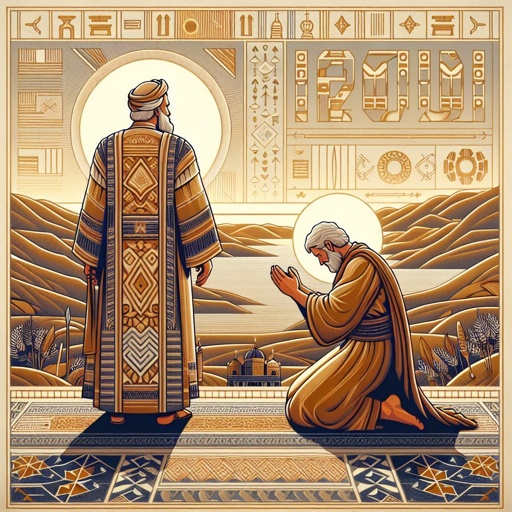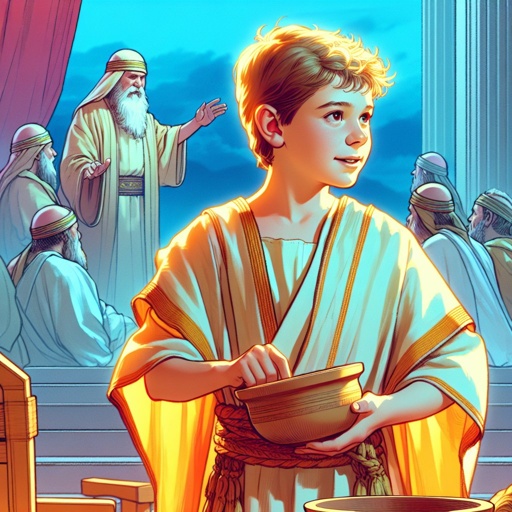What does 1 Samuel 1:1 mean?
"Now there was a certain man of Ramathaim-zophim, of mount Ephraim, and his name was Elkanah, the son of Jeroham, the son of Elihu, the son of Tohu, the son of Zuph, an Ephrathite:" - 1 Samuel 1:1

1 Samuel 1:1 - "Now there was a certain man of Ramathaim-zophim, of mount Ephraim, and his name was Elkanah, the son of Jeroham, the son of Elihu, the son of Tohu, the son of Zuph, an Ephrathite:"
The verse 1 Samuel 1:1 from the King James Version of the Bible states, "Now there was a certain man of Ramathaimzophim, of mount Ephraim, and his name was Elkanah, the son of Jeroham, the son of Elihu, the son of Tohu, the son of Zuph, an Ephrathite." This verse introduces us to the character of Elkanah, who plays a significant role in the narrative of 1 Samuel.
To truly understand the meaning and significance of this verse, it is important to consider the context in which it is situated. The book of 1 Samuel is part of the Old Testament and is filled with historical narratives and accounts of the time of the judges in Israel. The book begins by introducing us to the family of Elkanah and his wife Hannah. This verse serves as a foundational piece of information that sets the stage for the events that will unfold in the subsequent chapters of the book.
Elkanah is described as a man from Ramathaimzophim, a town in the region of Ephraim. This detail is important as it establishes Elkanah's geographical and ancestral background. The mention of Elkanah's lineage, tracing back to his ancestors Jeroham, Elihu, Tohu, and Zuph, serves to situate Elkanah within the larger historical and genealogical context of the Israelite people.
The name Elkanah itself holds significance as it means "God has possessed" or "God has created." This name serves as a reminder of the Israelites' belief in the providence and sovereignty of God. It also foreshadows the role that Elkanah will play in the unfolding events of the narrative, particularly in his relationship with his wife Hannah and their son Samuel.
Furthermore, the mention of Elkanah being an Ephrathite is significant as it links him to the tribe of Ephraim, one of the twelve tribes of Israel. The tribe of Ephraim held a prominent and influential position within the nation of Israel, and its members were known for their strength and leadership. By identifying Elkanah as an Ephrathite, the verse emphasizes his association with this esteemed tribe, further establishing his standing within the community.
This verse also sets the stage for the overarching theme of family and lineage that will permeate the narrative of 1 Samuel. Throughout the book, the importance of familial relationships, particularly the roles of parents and children, is a recurring motif. This verse lays the groundwork for the exploration of these themes as it introduces us to the lineage of Elkanah and provides insight into the family dynamics that will shape the narrative.
In addition to its literal and historical significance, this verse also holds symbolic and allegorical meanings. The mention of Elkanah's ancestry and heritage can be interpreted as a reflection of the Israelites' connection to their ancestral roots and the importance of preserving their cultural and religious heritage. It also serves as a reminder of the faithfulness of God to His people, as evidenced through the continuation of the Israelite lineage and the preservation of their traditions and customs.
Overall, 1 Samuel 1:1 serves as a foundational verse that introduces us to the character of Elkanah and sets the stage for the events that will unfold in the subsequent chapters of the book. Its historical, geographical, and ancestral details provide important context for understanding the narrative, while its deeper symbolic meanings serve to underscore the themes of family, lineage, and divine providence that are central to the book of 1 Samuel.
1 Samuel 1:1 Artwork

1 Samuel 1:1 - "Now there was a certain man of Ramathaim-zophim, of mount Ephraim, and his name was Elkanah, the son of Jeroham, the son of Elihu, the son of Tohu, the son of Zuph, an Ephrathite:"

1 Samuel 1:25 - "And they slew a bullock, and brought the child to Eli."

1 Samuel 6:1 - "And the ark of the LORD was in the country of the Philistines seven months."

1 Samuel 8:1 - "And it came to pass, when Samuel was old, that he made his sons judges over Israel."

1 Samuel 3:1 - "And the child Samuel ministered unto the LORD before Eli. And the word of the LORD was precious in those days; there was no open vision."

1 Samuel 1:10 - "And she was in bitterness of soul, and prayed unto the LORD, and wept sore."

1 Samuel 15:10 - "¶ Then came the word of the LORD unto Samuel, saying,"

1 Samuel 10:17 - "¶ And Samuel called the people together unto the LORD to Mizpeh;"

1 Samuel 7:15 - "And Samuel judged Israel all the days of his life."

1 Samuel 23:1 - "Then they told David, saying, Behold, the Philistines fight against Keilah, and they rob the threshingfloors."

1 Samuel 19:1 - "And Saul spake to Jonathan his son, and to all his servants, that they should kill David."

1 Samuel 5:1 - "And the Philistines took the ark of God, and brought it from Eben-ezer unto Ashdod."

1 Samuel 15:1 - "Samuel also said unto Saul, The LORD sent me to anoint thee to be king over his people, over Israel: now therefore hearken thou unto the voice of the words of the LORD."

1 Samuel 4:1 - "And the word of Samuel came to all Israel. Now Israel went out against the Philistines to battle, and pitched beside Eben-ezer: and the Philistines pitched in Aphek."

1 Samuel 13:1 - "Saul reigned one year; and when he had reigned two years over Israel,"

1 Samuel 2:26 - "And the child Samuel grew on, and was in favour both with the LORD, and also with men."

1 Samuel 1:12 - "And it came to pass, as she continued praying before the LORD, that Eli marked her mouth."

1 Samuel 15:31 - "So Samuel turned again after Saul; and Saul worshipped the LORD."

1 Samuel 3:4 - "That the LORD called Samuel: and he answered, Here am I."

1 Samuel 10:1 - "Then Samuel took a vial of oil, and poured it upon his head, and kissed him, and said, Is it not because the LORD hath anointed thee to be captain over his inheritance?"

1 Samuel 2:18 - "¶ But Samuel ministered before the LORD, being a child, girded with a linen ephod."

1 Samuel 29:1 - "Now the Philistines gathered together all their armies to Aphek: and the Israelites pitched by a fountain which is in Jezreel."

1 Samuel 25:1 - "And Samuel died; and all the Israelites were gathered together, and lamented him, and buried him in his house at Ramah. And David arose, and went down to the wilderness of Paran."

1 Samuel 3:10 - "And the LORD came, and stood, and called as at other times, Samuel, Samuel. Then Samuel answered, Speak; for thy servant heareth."

1 Samuel 3:16 - "Then Eli called Samuel, and said, Samuel, my son. And he answered, Here am I."

1 Samuel 15:34 - "¶ Then Samuel went to Ramah; and Saul went up to his house to Gibeah of Saul."

1 Samuel 12:1 - "And Samuel said unto all Israel, Behold, I have hearkened unto your voice in all that ye said unto me, and have made a king over you."

1 Samuel 1:27 - "For this child I prayed; and the LORD hath given me my petition which I asked of him:"

1 Chronicles 6:28 - "And the sons of Samuel; the firstborn Vashni, and Abiah."

1 Samuel 3:15 - "¶ And Samuel lay until the morning, and opened the doors of the house of the LORD. And Samuel feared to shew Eli the vision."